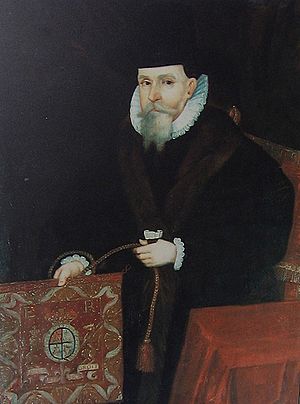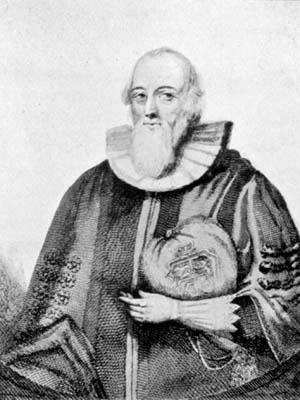Adam Loftus (bishop) facts for kids
Quick facts for kids The Most Reverend Adam Loftus |
|
|---|---|
| Archbishop of Dublin Primacy of Ireland |
|
 |
|
| Church | Church of Ireland |
| Province | Dublin |
| Diocese | Dublin and Glendalough |
| Enthroned | 9 August 1567 |
| Reign ended | 5 April 1605 |
| Predecessor | Hugh Curwen |
| Successor | Thomas Jones |
| Other posts | Archbishop of Armagh (2 March 1563 – 9 August 1567) |
| Orders | |
| Consecration | 1563 by Hugh Curwen |
| Personal details | |
| Born | 1533 Yorkshire Dales, England |
| Died | 5 April 1605 (age 71/72) Dublin, Ireland |
| Nationality | English |
| Denomination | Anglican |
| Parents | Edward Loftus |
| Spouse | Jane Purdon (m. c. 1560) |
| Children | Dudley Loftus, Edward Loftus, and 10 others |
| Alma mater | Trinity College, Cambridge |
Adam Loftus (born around 1533 – died April 5, 1605) was an important figure in Ireland during the time of Queen Elizabeth I. He served as the Archbishop of Armagh and later as the Archbishop of Dublin. He was also the Lord Chancellor of Ireland, which meant he was in charge of the country's legal system. A major achievement was helping to found Trinity College Dublin, where he became the first leader, known as the Provost.
Contents
Early Life and Education
Adam Loftus was born in 1533 in the Yorkshire Dales in England. His father passed away when Adam was only eight years old. Even though his family had ties to the Catholic Church, Adam chose to follow the Protestant faith early in his life.
He went to Trinity College, Cambridge, a famous university in England. It is said that he impressed the young Queen Elizabeth with his intelligence and speaking skills. Queen Elizabeth became his supporter throughout her reign.
Moving to Ireland
In 1560, Loftus moved to Ireland as a chaplain to a powerful English lord, Thomas Radclyffe, 3rd Earl of Sussex. He quickly became known as a smart and trusted advisor to the English leaders in Dublin.
In 1563, when he was just 30 years old, he became the Archbishop of Armagh. This was a very important religious position.
Challenges as Archbishop
The country was not always peaceful. After some disagreements with Shane O'Neill, a powerful Irish leader, Loftus moved his home to Dublin in 1564.
To help with his income, Queen Elizabeth also made him the Dean of St Patrick's Cathedral, Dublin. This led to some disagreements with other church leaders.
In 1567, Loftus became the Archbishop of Dublin. Queen Elizabeth wanted him to make changes to the Church in Ireland. He also took on important government roles, eventually becoming the Lord Chancellor of Ireland in 1581. This made him one of the most powerful people in the country.
In 1582, Loftus bought land and built Rathfarnham Castle near Dublin. He moved into the castle in 1585. Today, you can visit this castle, which has been restored.
Religious Changes in Ireland
During Loftus's time, there were big changes in religion and politics in Ireland. The Pope had declared Queen Elizabeth I to be excommunicated (removed from the Catholic Church). This meant that many Roman Catholics in Ireland were seen as disloyal to the Queen.
Adam Loftus played a key role in supporting the Church of Ireland, which was the Protestant church established by the English Crown. This was a time of great tension between Protestants and Catholics.
Founding Trinity College Dublin
Loftus had a big disagreement with another English official, Sir John Perrot, about where to build a new university in Ireland. Perrot wanted to use St Patrick's Cathedral, Dublin, but Loftus wanted to keep the Cathedral as a main Protestant church.
Loftus won this argument with the help of Queen Elizabeth. Trinity College Dublin was founded in its current location, and Loftus became its first leader (Provost) in 1593. He named it after his old college in Cambridge.
The time was marked by several conflicts, like the Desmond Rebellions and the Nine Years' War. These wars often mixed political and religious differences. Because of the unrest, Protestantism did not spread widely among the Irish people. Many Irish Catholics, including both native Irish families and older English families who had settled in Ireland centuries before, united against the English Crown.
Family Life
Around 1560, Adam Loftus married Jane Purdon. They had a large family with twenty children, though eight of them sadly passed away when they were very young. The twelve children who grew up were:
- Sir Dudley Loftus
- Sir Edward Loftus (died 1601), who was killed in battle
- Adam Loftus, who also died in battle
- Sir Thomas Loftus
- Henry Loftus
- Isabella Loftus, who married Sir William Ussher
- Anne Loftus, who married Sir Henry Colley and was an ancestor of the famous Duke of Wellington
- Catherine Loftus, who married Sir Francis Berkeley
- Martha Loftus, who married Sir Thomas Colclough
- Dorothy Loftus, who married Sir John Moore
- Alice Loftus, who married Sir Henry Warren
- Margaret Loftus, who married Sir George Colley
Death and Legacy
Adam Loftus passed away in Dublin in 1605, at about 71 or 72 years old. He was buried in St Patrick's Cathedral, Dublin, the very building he had worked hard to protect. Many portraits of him can still be seen today at Trinity College Dublin, the university he helped create.
He was known for his strong personality and his important role in the legal system of Ireland during Queen Elizabeth's reign.
| Church of Ireland titles | ||
|---|---|---|
| Preceded by George Dowdall |
Archbishop of Armagh 1562–1567 |
Succeeded by Thomas Lancaster |
| Preceded by Hugh Curwen |
Archbishop of Dublin 1567–1605 |
Succeeded by Thomas Jones |
| Political offices | ||
| Preceded by Robert Weston |
Lord Chancellor of Ireland (as Lord Keeper) 1573–1576 |
Succeeded by Sir William Gerard |
| Preceded by Sir William Gerard |
Lord Chancellor of Ireland 1581–1605 |
Succeeded by In commission – next held by Archbishop Thomas Jones |
| Academic offices | ||
| Preceded by Inaugural office |
Provost of Trinity College Dublin 1592–1594 |
Succeeded by Walter Travers |


